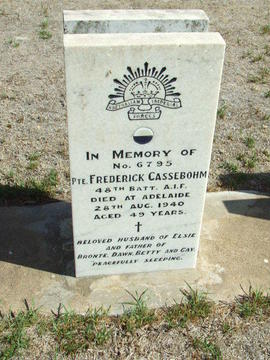CASSEBOHM (CASSERBOHM), Frederick
| Service Number: | 6795 |
|---|---|
| Enlisted: | Not yet discovered |
| Last Rank: | Private |
| Last Unit: | 27th Infantry Battalion |
| Born: | Kent Town, SA, Australia , 1891 |
| Home Town: | Kent Town, Norwood Payneham St Peters, South Australia |
| Schooling: | Not yet discovered |
| Occupation: | Salesmen |
| Died: | Natural Cases , Adelaide , 28 August 1940 |
| Cemetery: |
West Terrace Cemetery (AIF Section) |
| Memorials: | Rose Park Public School WW1 Honour Board |
World War 1 Service
| 30 Oct 1917: | Involvement Private, 6795, 27th Infantry Battalion, --- :embarkation_roll: roll_number: '15' embarkation_place: Melbourne embarkation_ship: HMAT Aeneas embarkation_ship_number: A60 public_note: '' | |
|---|---|---|
| 30 Oct 1917: | Embarked Private, 6795, 27th Infantry Battalion, HMAT Aeneas, Melbourne |
Help us honour Frederick Cassebohm (Casserbohm)'s service by contributing information, stories, and images so that they can be preserved for future generations.
Add my storyBiography contributed by St Ignatius' College
Frederick Casserbohm or Cassebohm, was a soldier who fought in the 1st World War. Frederick was born in Kent Town, in South Australia in approximately 1891, the exact date was never recorded.(2) He was a natural born British subject meaning he was born in Australia. His mother’s name was Clara Cassebohm and she was Frederick’s next of kin.(1) Fredrick was a salesmen before he enlisted to go to the war and he was single meaning he didn’t have any children by this time. He weighed roughly 62kg and he was 5 feet and 7.25 inches tall. His skin complexion was fair, his eye colour was blue and he had brown hair. His chest measurement was 38.5 inches. (5)
On the 23rd of April, 1917, Frederick enlisted into the Australian Imperial Force (AIF). Frederick had to undergo some training as he had no training what so ever. He trained at Mitcham from the 24th of May, 1917 to the 1st of June. He was then placed into the 27th Infantry Battalion, which was one of the many units. On the 10th of October in 1917, Frederick embarked on the ‘Aeneas’ to Devonport in England. On the 11th of March in 1918, Frederick was appointed Corporal, which is the next ranking up from Private and then not long after that ( 31st of March, 1918) he was demoted back to a Private. He then proceeded overseas to France, Fovant via Dover on the 1st of April. He then transferred from the 27th Battalion, to the 48th Battalion. Then in November of 1918 the war ended. (5)
During Frederick’s time in the war, he spent a few days in hospital was sent to one of the Bulford hospitals where he stayed there for 33 days and then after 2 weeks of being let go, he was sent back to the hospital. (2)
Frederick was sent back to Australia via the ‘Euripides’ and discharged on the 19th of November in 1919.(2) He returned back home to his family and continued his life as a salesman. He received 3 medals, the ‘Star’ medal, the ‘British War’ medal and the ‘Victory’ medal. (2) (5)
Frederick eventually married a woman named Else, who then became his wife and the mother to his 4 children. His kids' names were: Bronte, Dawn, Betty and Gay. (6) He then passed away on the 28th of August in 1940 (aged 49) and was buried in the West Terrace Cemetery. (4) (6) (5)
Referencing
1. https://rslvirtualwarmemorial.org.au/explore/people/240881
2. https://recordsearch.naa.gov.au/SearchNRetrieve/Interface/DetailsReports/ItemDetail.aspx?Barcode=3218719&isAv=N
3. https://s3-ap-southeast-2.amazonaws.com/rslvwm/comfy/cms/files/files/000/000/780/original/Writing_a_Biography.pdf
4. https://goo.gl/1ZxDtR
5. https://rslvirtualwarmemorial.org.au/explore/people/25302
6. https://da.billiongraves.com/grave/FREDERICK-CASSEBOHM/12257195
7. https://www.awm.gov.au/collection/U51467











